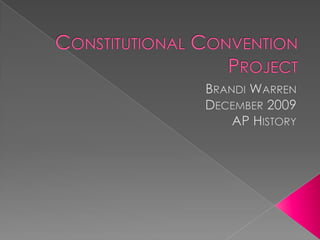
Constitutional Convention Project
- 1. Constitutional Convention Project Brandi Warren December 2009 AP History
- 2. Economic Conditions post American Revolutionary War Due to the limitations of the Articles of Confederation, the central Congress was held back in efforts to negotiate commercial treaties. Because the United States was no longer part of the complex British mercantile system, key exports were lost. This included rice, indigo, and tobacco. In Southern states, the loss of once profitable commodities forced planters to convert to cotton production, made even more lucrative through the invention of the cotton gin in 1793. Small land owners, small business owners, and farmers were facing hard times due to the slight depression that followed the American Revolution. The economy was down.
- 3. Shay’s Rebellion 1786-1787. Farmers were angered because they were facing hard times due to the depression that followed the American Revolution. They petitioned the state government to issue paper money and to halt foreclosure of mortgages on their property and their own imprisonment for debt as a result of high land taxes. When the state government failed to help these farmers out Daniel Shay and a few others led an armed revolt that kept the county courts from sitting to make judgments for debt. They forced the state supreme court at Springfield to adjourn. 4,400 men were sent to contain the rebellion. Before these troops got to Springfield the soldiers there had attacked the federal arsenal. The rebels, lost several men and set off again. Troops followed them and finally caught up. Shays escaped to Vermont. Most of the leaders were let off easy and Shays was finally pardoned in June, 1788. The rebellion influenced Massachusetts's ratification of the U.S. Constitution
- 4. Articles of Confederation: Weaknesses ONE: A weak National Government – central government wasn't able to pass laws or taxes if all the states did not approve TWO: Congress could not tax or regulate commerce among states THREE: No common currency – made it harder to buy products between states. FOUR: Just one vote per state, size didn’t matter – Unequal Representation among states FIVE: No executive or judicial branch – No way to balance out power or have a way to provide justice.
- 8. The Great Compromise VA Plan New Jersey Plan proposed by Edmund Randolph favored the interest of the larger states smaller states feared that they would have no power proposed three separate branches of government and a bicameral legislature where representation will be based upon states population or money contributions. proposed by William Paterson Favored the interest of the smaller sates this plan resembled our current plan of government, The Articles of Confederation This plan proposed a one-house national legislature with representatives selected by state legislatures. Each state will be able to cast one vote. also proposed a supreme court appointed for life by the executive officers
- 9. 3/5 Compromise A compromise between Southern and Northern states reached during the Constitutional Convention. Stating that three-fifths of the population of slaves would be counted for tally purposes regarding both the distribution of taxes and the assignment of the members of the United States House of Representatives. Delegates against slavery wished to count only the free people living within a state. Delegates supporting slavery wanted to count slaves in their actual numbers. Since slaves could not vote, slaveholders would have the benefit of increased representation in the House and the Electoral College; taxation was more of a secondary issue.The final compromise of counting "all other persons" as only three-fifths of their actual numbers reduced the power of the slave states relative to the original southern proposals, but increased it over the northern position.
- 10. Political Parties Federalist Anti-Federalist Advocates of a strong central government Somewhat pessimistic about human nature believed that the government must resist the passions of the general public One of the government's prime functions was to maintain order Most were large landowners, bankers and businessmen Favored the government's efforts to encourage and protect American industry Supported the British, with whom they had strong trade ties Opposed the French, who at the time were convulsed by the French Revolution Supporters of the ratification of the Constitution in the years between 1787 and 1790 opposed the creation of a stronger U.S. federal government desire to establish a weak central government (had been created by the Articles of Confederation) opposed the ratification of the Constitution of 1787 worried that the position of president might evolve into a monarchy desire for strong state governments support of many small farmers and small landowners support of debtor elements who felt that strong state legislatures were more sympathetic to them than a strong central government. Non supporters of the ratification on the Constitution in years between 1787 and 1790
- 11. I would support the Federalist I would have supported the Federalist party if I had been around during the Constitutional Convention. I say this because I like order and control. And I think that a strong central government would be the only was to maintain order and control in a new country. Its also the only way to keep things just for everyone. If ever state had all its own powers it would be more like little countries rather then states of one country and not everyone would be treated justly. I believe in checks and balances of course, because without these we would be a monarchy, but I do believe that the central government could be to weak and that would only lead to chaos and many disputes.
- 12. Sources Slide 2 http://colonial-america.suite101.com/article.cfm/effects_of_the_american_revolution Image: www.vailhs.net/.../6The%20American%20Revolution%20Charts%20and%20Graphs.p... - Slide 3 Shays http://www.infoplease.com/ce6/history/A0844765.html Image: http://www.constitutioncenter.org/timeline/flash/assets/asset_upload_file867_11926.jpg Slide 4 http://ushistory.pwnet.org/resources/pdf/USI7a.pdf Slide 5 http://teachingamericanhistory.org/convention/ http://wiki.answers.com/Q/What_was_the_purpose_of_the_Constitutional_Convention Image: https://faculty.rpcs.org/leee/images/largeconvention.jpg Slide 6 http://www.sparknotes.com/history/american/constitution/terms.html Slide 7 http://www.cyberlearning-world.com/nhhs/amrev/begin.htm Slide 8 http://en.wikipedia.org/wiki/Three-fifths_compromise Slide 9 http://www.u-s-history.com/pages/h445.html http://en.wikipedia.org/wiki/Anti-Federalism Slide 10 http://www.u-s-history.com/pages/h445.html